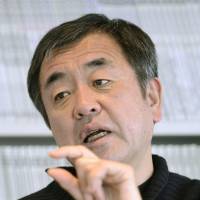Kengo Kuma, 58, is an internationally renowned architect who designed the new Kabukiza theater in Tokyo's Ginza district that opened early last month.
A multiple award winner, he has designed a range of houses, buildings and museums and receives orders from all over the world.
Kuma nevertheless felt tremendous pressure when first asked to design the iconic fifth-generation Kabukiza, a theater with more than 120 years of history behind it.
He said that when thinking about the nation following the 2011 Great East Japan Earthquake as well as changes in areas surrounding the theater, he felt the new Kabukiza should be at "the core of urban rejuvenation."
Kuma, who has a master's degree from the University of Tokyo, explained that the facility can fulfill its duty when it "carries the significance of festivity once again, or if put in a more modern language — cultural tourism."
A native of Yokohama, Kuma may appear to be a specialist in urban architecture when considering some of his past works, including the Nezu Museum in Aoyama, one of Tokyo's most fashionable districts.
But he is also famous for architectural work in the natural environment, such as the Kiro-san Observatory in Imabari, Ehime Prefecture, and the Noh Stage in the Forest in Tome, Miyagi Prefecture.
He said his creed is to create buildings together with local people based on deep discussions with them.
When designing the new Kabukiza, he worked both with kabuki performers and others involved in the traditional art form as well as people from the Ginza shopping district. He decided to make only minor changes to the theater, keeping its symbolic "karahafu" gable roof with an undulating curve because he found it "necessary," although he knew such a design could be regarded as taboo coming from a modern architect.



